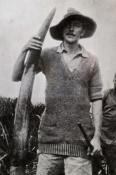
War Memorial
| Captain Richard Cecil Milman CROFTON (80159) MC and Bar | |
|
Royal Artillery attached to the East African Intelligence Corps Date of birth: 25th August 1895 Date of death: 15th June 1941 Died of wounds aged 45 Buried at Nairobi War Cemetery Plot 2 Grave H Grave 1 |

|
| Richard Cecil Milman "Dickie" Crofton was born at Tilford, Farnham in Surrey on the 25th of August 1895 the only child of Major Caldwell Henry Crofton, Royal Field Artillery, and the author Helen Rose Ann (nee Milman) Crofton of "Heathfield", Tilford in Surrey. He was educated at Hazelwood School until December 1908 where he was a member of the Choir and of the Cricket XI in 1907 and 1908. He was a member of the Football XI in 1908. The school magazine wrote the following on his 1907 cricket season: - "Bowls a beautiful length and nips smartly off the pitch; has already accomplished some remarkable performances. His fielding is good but his batting indifferent." Of his 1908 cricket season they wrote: - "Probably the finest bowler we have ever had at Hazelwood, whilst his batting has developed to such an extent that pride of place is his in both in averages and analysis." The magazine wrote the following of his 1908 football season: - "(Left half) - A marvellous tackler in the light of his physique; is the incarnation of "grit" and in feeding his own forward lines displays no little acumen." On leaving the school the magazine wrote the following of him: - "Perhaps the finest all round cricketer there has been at Hazelwood - though he will chiefly be remembered for his wonderful bowling. Also a fine golfer and wonderful trier at football and all games, "Dickie" - a big soul in a small body. A valuable member of the choir and beloved by everybody his loss is irreparable." He went on to Wellington College where he was in Hopetoun's House from the January 1909 to 1913. He was a member of the Cricket XI from 1911 to 1913 and had a trial for Surrey County Cricket Club in 1913. He went on to the Royal Military Academy at Woolwich in 1914 and was commissioned as a 2nd Lieutenant in the Royal Field Artillery on the 10th of February 1915,embarking for France on the 17th of April 1915 where he joined the Chestnut Troop, Royal Horse Artillery. He was promoted to Lieutenant on the 8th of August 1916 and was seconded to the General Staff as a General Staff Officer Grade 2, becoming an Aide De Camp the same year. In December 1916 he was on the staff of 6th Army Corps. He was promoted to Acting Captain on the 26th of April 1918 while serving with A Battery, 16th Brigade, Royal Horse Artillery and later to Acting Major a rank he relinquished on the 25th of August 1918; he was promoted to Temporary Major on the same date. He won the Military Cross which was announced in the London Gazette of the 26th of July 1918 and the citation reads;- "For conspicuous gallantry and initiative. He brought his battery through shell fire which killed and wounded several horses, and then came into action, and from an exposed observation post brought effective fire to bear on a railway station which was crowded with enemy troops. His bold handling of his battery was a fine example to all, and he did considerable damage to the enemy." He won a Bar to his Military Cross which was announced in the London Gazette of the 11th of January 1919; the citation reads:- "When observing and directing the fire of a battery under heavy shell fire in a very exposed observation post he frequently avoided casualties by his courage and promptness when clearing killed and wounded horses away from the teams which had been hit." He reported for duty, every day he was in France even when wounded and was mentioned in despatches. He was promoted to Brevet Major in the King's Birthday Honours List of the 3rd of June 1919. He relinquished the rank of Temporary Major on the 28th of September 1920 and resigned his commission on the 15th of April 1921 being granted the rank of Honorary Captain. On the 11th of February 1929 a suit for divorce was filed by Humfrey Trice Martin against his wife, Florence Evangeline Cloete (nee Northey formerly Clowes), in which Richard Crofton was cited as a co-respondent. The petition alleged that he and Florence Martin had cohabited at his home at 48 Leinster Square, London from the 17th of December 1928. The decree nisi was granted on the 28th of October 1929 and the couple were married in Africa on the 8th of May 1930. His new wife had a daughter, Elizabeth Clowes, who he is thought to have adopted as she was known as Crofton in later life. They went to live and work on a large estate at Gilgil in Kenya Colony where they were regarded as members of the “Happy Valley” set. He enjoyed big game hunting, particularly for lions. On the outbreak of the Second World War in 1939 he volunteered for service but was rejected on medical grounds. Instead he was given command of a unit of Irregulars attached to the East African Intelligence Corps. In February 1941 he was hit in the thigh by a ricochet bullet and died of his injuries at 2 General Hospital in Nairobi four months later. A friend wrote: - "It was impossible to know whether he suffered very much as his indomitable courage prevented him from showing it." He is commemorated on the war memorial at Wellington College and on the memorial at Tilford. |
|
 | |
| Went on to Wellington College |
Back